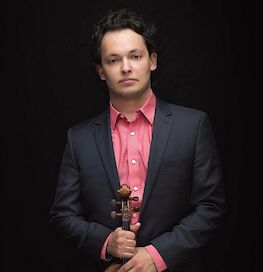Concerto for Violin and Orchestra
- Year
- 2021
- Duration
- 30'
- Dedication
- Robert Stein
- Premiere
- October, 15th 2021
Max M. & Margorie S. Fisher Music Center
Detroit Symphony Orchestra - Purchase
- Schott Helicon
Program Notes

Yevgeny Kutik- Violinist
Concerto for Violin and Orchestra
Over the years, I have written a series of concertos including a Percussion Concerto for Christopher Lamb, principal percussionist of the New York Philharmonic, a Piano Concerto for Emanuel Ax, and one for guitarist, Sharon Isbin. Leonard Slatkin has conducted the premiere performances of many of my works with support that extends back some four decades when I served as the Saint Louis Symphony’s first composer-in-residence.The genesis for the Violin Concerto originally began as a short soliloquy for violin and strings commissioned by the Seattle Symphony to commemorate my friend, Gerard Schwarz’s retirement as the orchestra’s musical director. While composing the piece for Seattle, I had always planned to later expand and re-imagine the music as part of a larger scale work for violin and orchestra. When Gerard also performed the music with his All-Star Orchestra and violinist, Yevgeny Kutik, I was enthralled with Yevgeny’s masterful and nuanced performance and realized I had found “the” soloist to premiere this new expanded work. Yevgeny Kutik brings a dramatic and an emotional arc to his impressive technique and captivating musical personality, and that vision remained in my mind’s ear all during the writing of the concerto.
The concerto consists of two extended movements. The first opens with a slow unfolding harmony and a deep repeated orchestral pedal that introduces a darkly expressive melodic line played by cellos in their low register. The brooding character of these musical elements form the basis of the materials developed in this movement.
In the second movement, the violin presents a rapid four-note figure leading to a sudden and dramatic ascending arpeggiated gesture that is picked up by the piano and pitched percussion as a sustained and ringing sonority. This notion of transformation of a musical idea from one context into new and different environments was an endlessly fascinating process of discovery I continually explored throughout both movements of the work.
Concerto for Violin and Orchestra
Concerto for Violin and Orchestra
Over the years, I have written a series of concertos including a Percussion Concerto for
Christopher Lamb, principal percussionist of the New York Philharmonic, a Piano Concerto for Emanuel Ax, and one for guitarist, Sharon Isbin. Leonard Slatkin has conducted the premiere performances of many of my works with support that extends back some four decades when I served as the Saint Louis Symphony’s first composer-in-residence.The genesis for the Violin Concerto originally began as a short soliloquy for violin and strings commissioned by the Seattle Symphony to commemorate my friend, Gerard Schwarz’s retirement as the orchestra’s musical director. While composing the piece for Seattle, I had always planned to later expand and re-imagine the music as part of a larger scale work for violin and orchestra. When Gerard also performed the music with his All-Star Orchestra and violinist, Yevgeny Kutik, I was enthralled with Yevgeny’s masterful and nuanced performance and realized I had found “the” soloist to premiere this new expanded work. Yevgeny Kutik brings a dramatic and an emotional arc to his impressive technique and captivating musical personality, and that vision remained in my mind’s ear all during the writing of the concerto.
The concerto consists of two extended movements. The first opens with a slow unfolding
harmony and a deep repeated orchestral pedal that introduces a darkly expressive melodic line played by cellos in their low register. The brooding character of these musical elements form the basis of the materials developed in this movement.In the second movement, the violin presents a rapid four-note figure leading to a sudden and dramatic ascending arpeggiated gesture that is picked up by the piano and pitched percussion as a sustained and ringing sonority. This notion of transformation of a musical idea from one context into new and different environments was an endlessly fascinating process of discovery I continually explored throughout both movements of the work.
-Joseph Schwantner
News
Reviews
Colin Anderson
Detroit Symphony Orchestra – Leonard Slatkin conducts two world premieres & Tchaikovsky’s Fifth Symphony – Yevgeny Kutik plays Joseph Schwantner’s Violin Concerto
Oct 17, 2021 | Concert Reviews, Videos | 0 comments
Saturday, October 16, 2021Orchestra Hall, Max M. & Marjorie S. Fisher Music Center, Woodward Avenue, Detroit, Michigan
For the third time of asking during this DSO subscription week Leonard Slatkin (music director laureate) introduced new works from two senior composers, Samuel Adler and Joseph Schwantner.
Adler’s fifteen-minute Mirror Images, for full orchestra, proved diverting in its alternations of slow and fast, seriousness and humour, mysterious suggestiveness/sad lyricism and full-on dance routines; Bernstein, Hindemith (especially) and Shostakovich are in the mix, but Adler is clearly his own man, and it was good to see the ninety-three-year-old composer in the audience belying his age.
Schwantner’s thirty-five-minute Violin Concerto, written for Yevgeny Kutik, is a compelling piece. No less colourful in terms of scoring, if reducing heavy brass (two trumpets, one trombone) while including a piano and a harp and using percussion subtly and variedly. During the fascinating first movement, which opens darkly, it would be pointless to second-guess what happens next, but the transformations are made inevitable. The second and final movement, beginning dramatically, is animated and beguilingly detailed, fading to dusky reminiscences, then rising to affirmation. Kutik (a violinist new to me and quite a find) gave a technically brilliant, rich-toned and musically intense performance, Slatkin in total control of the mosaic-like orchestration. As for the piece itself, it needs to be listened to again to fully appreciate the many facets; however, even if it’s perhaps too easy a reference, if you love Barber’s Violin Concerto, you’ll love the Schwantner, and he too was present.
Colin Anderson, Classical Sources
– Colin Anderson Read Complete Review